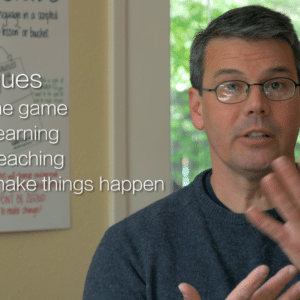While fluency hunting, you constantly double check your sense of the accent in play through my turn/your turn, maintaining a back and forth rhythm between yourself, your fellow players, and your fluent fool.
Everything honest is a conversation.
There are countless examples of alternating flows in the natural world. Back and forth exchanges are a circulatory pump – the action of the heart, migrations, tides, seasons, days and nights. This is no less true in the exchange between two human beings. A one way lecture often generates stagnation and lethargy, yet a two way conversation can build upon itself and create more life than was there to begin with.
Technique My Turn/Your Turn comes closest, of all the techniques, to being a near-universal rule of game play. By applying my turn/your turn, you can change any activity into a game – and what games do not have “turns”, in some form or another? Very few. Even apparently rule-less games like “the Human Knot” seem to require players to take turns in order to resolve the game (a good example of applying technique to a problem).
Any human environment benefits from a thoughtful application of my turn/your turn. From politics, to work, to family life. An artist, such as a sculptor, applies this technique through action, and then reflection. Rather than forcing a shape onto a chunk of marble, the sculptor chips, then looks at the marble, letting it speak, then chips again, then looks again. This is the artist’s conversation.
Vital to WAYK, this technique drives new players to begin “leading” the game themselves, as soon as possible – a critical factor in skill diffusion. Even if the game ends after 5 minutes, a new player has at least one bite-sized piece they can teach.
Introducing the technique in language acquisition
This technique is applied quite early, as soon as possible.
Short: “Technique: My Turn/Your Turn. It was my turn first. Now it’s your turn. You lead us. But we will pull you through it…”
Applying the technique in language acquisition
As soon as the player has the absolute minimal ability to be pulled through leading a round, that is a good time to hand off leadership to them.
- tq Bite-sized Pieces means the new player, now leading, only has a tiny new piece to focus on, so they don’t become overwhelmed.
- tq Pull them through it means that the new player is only psychologically the leader; in fact, the original game leader is still going first.
- tq Copy-cat directs the new player who is “leading” the round to follow the lead of the most confident player in the game.
But what about…?
If a new player balks at leading a round of the game, there are several possible explanations.
- Are you sure you gave them a small enough Bite-sized Piece?
- Do they understand, even though they’re “leading”, they still only have to copy-cat the most confident player (who will pull them through it)?
- Did you apply newbie in the lunatic fringe before having them in the inner circle?






I am very touched by the simplicity, and the profoundness of this writing…
More than a technique, it is becomming a way of life : once you have been exposed to wayk, there is no going back!
BTW, the boy in the picture was at his last turn: he is in checkmated after a short rock and roll game. I even wonder why he is thinking, Tc Obvious!
Thank you Claude! We indeed think of WAYK as a new culture of interaction, not just a game or set of techniques.